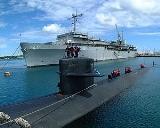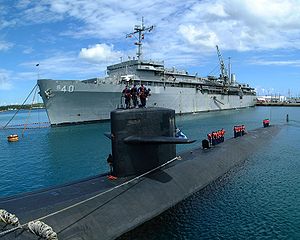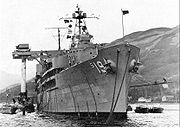
Submarine tender
Encyclopedia

Ship
Since the end of the age of sail a ship has been any large buoyant marine vessel. Ships are generally distinguished from boats based on size and cargo or passenger capacity. Ships are used on lakes, seas, and rivers for a variety of activities, such as the transport of people or goods, fishing,...
that supplies and supports submarine
Submarine
A submarine is a watercraft capable of independent operation below the surface of the water. It differs from a submersible, which has more limited underwater capability...
s.
Submarines are small compared to most oceangoing vessels, and generally do not have the ability to carry large amounts of food, fuel, torpedo
Torpedo
The modern torpedo is a self-propelled missile weapon with an explosive warhead, launched above or below the water surface, propelled underwater towards a target, and designed to detonate either on contact with it or in proximity to it.The term torpedo was originally employed for...
es, and other supplies, nor to carry a full array of maintenance equipment and personnel. The tender carries all these, and either meets up with the submarines at sea to replenish them or provides these services while docked at a port near the area where the submarines are operating. In some navies, the tenders were equipped with workshops for maintenance, and as floating dormitories with relief crews.
Unable to operate conventional surface tenders during World War II
World War II
World War II, or the Second World War , was a global conflict lasting from 1939 to 1945, involving most of the world's nations—including all of the great powers—eventually forming two opposing military alliances: the Allies and the Axis...
, the German Navy used Type XIV submarines
German Type XIV submarine
The Type XIV U-boat was a modification of the Type IXD, designed to resupply other U-boats. They were nicknamed "Milchkuh/Milchkühe " . They had no torpedo tubes or deck guns, only anti-aircraft guns. Due to its large size, the Type XIV could resupply other boats with 400 tons of fuel, four...
(milchcows) as tenders instead.
In the Royal Navy
Royal Navy
The Royal Navy is the naval warfare service branch of the British Armed Forces. Founded in the 16th century, it is the oldest service branch and is known as the Senior Service...
, the term used for a submarine tender is "submarine depot ship", for example HMS Medway and HMS Maidstone
HMS Maidstone (1937)
HMS Maidstone was a submarine depot ship of the Royal Navy.-Facilities:She was built to support the increasing numbers of submarines, especially on distant stations, such as the Mediterranean and the Pacific Far East...
.
With the increased size and automation of modern submarines, plus their reliance on nuclear power
Nuclear power
Nuclear power is the use of sustained nuclear fission to generate heat and electricity. Nuclear power plants provide about 6% of the world's energy and 13–14% of the world's electricity, with the U.S., France, and Japan together accounting for about 50% of nuclear generated electricity...
, tenders are no longer as necessary as they once were.

United States Navy
The United States Navy is the naval warfare service branch of the United States Armed Forces and one of the seven uniformed services of the United States. The U.S. Navy is the largest in the world; its battle fleet tonnage is greater than that of the next 13 largest navies combined. The U.S...
, submarine tenders are considered auxiliaries, with hull classification symbol
Hull classification symbol
The United States Navy, United States Coast Guard, and United States National Oceanic and Atmospheric Administration use hull classification symbols to identify their ship types and each individual ship within each type...
"AS". , the Navy only maintains two such tenders, and .
The Russian Navy decommissioned all its Don class
Don class submarine tender
The Don class submarine tender was the NATO reporting name for a group of submarine tenders built for the Soviet Navy in the late 1950s. The Soviet designation was Project 310 Batur.-Design:...
and Ugra
Ugra class submarine tender
The Ugra class was the NATO reporting name for a group of submarine tenders built for the Soviet Navy in the late 1960s. One extra ship the INS Amba was built for the Indian Navy to a modified design. The Soviet designation was Project 1886 The ships were intended to provide afloat support,...
class tenders inherited from the Soviet Navy
Soviet Navy
The Soviet Navy was the naval arm of the Soviet Armed Forces. Often referred to as the Red Fleet, the Soviet Navy would have played an instrumental role in a Warsaw Pact war with NATO, where it would have attempted to prevent naval convoys from bringing reinforcements across the Atlantic Ocean...
by 2001. The last remaining ship of this class was the INS Amba (A54)
INS Amba (A54)
INS Amba was the only submarine tender ship in service with the Indian Navy. It is a modified Soviet design built to Indian specifications in Nikolayev in 1968...
, initially sold to the Indian Navy
Indian Navy
The Indian Navy is the naval branch of the armed forces of India. The President of India serves as the Commander-in-Chief of the Navy. The Chief of Naval Staff , usually a four-star officer in the rank of Admiral, commands the Navy...
in 1968 for use with their fleet of s. She was reportedly decommissioned from service in July 2006.
See also
- Destroyer tenderDestroyer tenderA destroyer tender is a ship designed to provide maintenance support to a flotilla of destroyers or other small warships. The use of this class has faded from its peak in the first half of the 20th century as the roles of small combatants have evolved .Due to the increased size and automation of...
- Jonas PleškysJonas PleškysJonas Plaskus or Jonas Pleškys was a Soviet Navy submarine tender captain born in Lithuania. He died in California, United States....
, a Soviet NavySoviet NavyThe Soviet Navy was the naval arm of the Soviet Armed Forces. Often referred to as the Red Fleet, the Soviet Navy would have played an instrumental role in a Warsaw Pact war with NATO, where it would have attempted to prevent naval convoys from bringing reinforcements across the Atlantic Ocean...
captain who defectedDefectionIn politics, a defector is a person who gives up allegiance to one state or political entity in exchange for allegiance to another. More broadly, it involves abandoning a person, cause or doctrine to whom or to which one is bound by some tie, as of allegiance or duty.This term is also applied,...
with his submarine tender.

